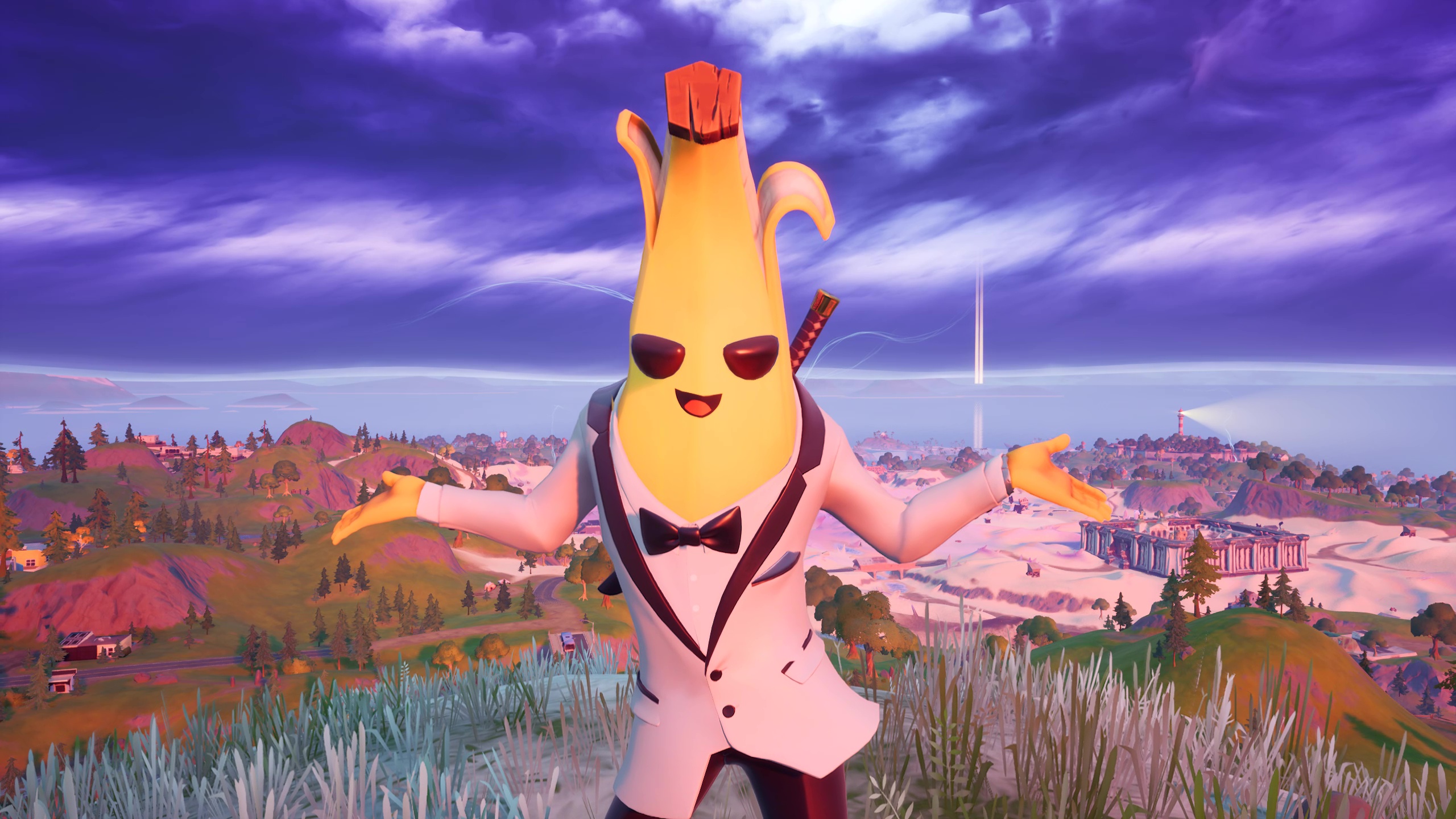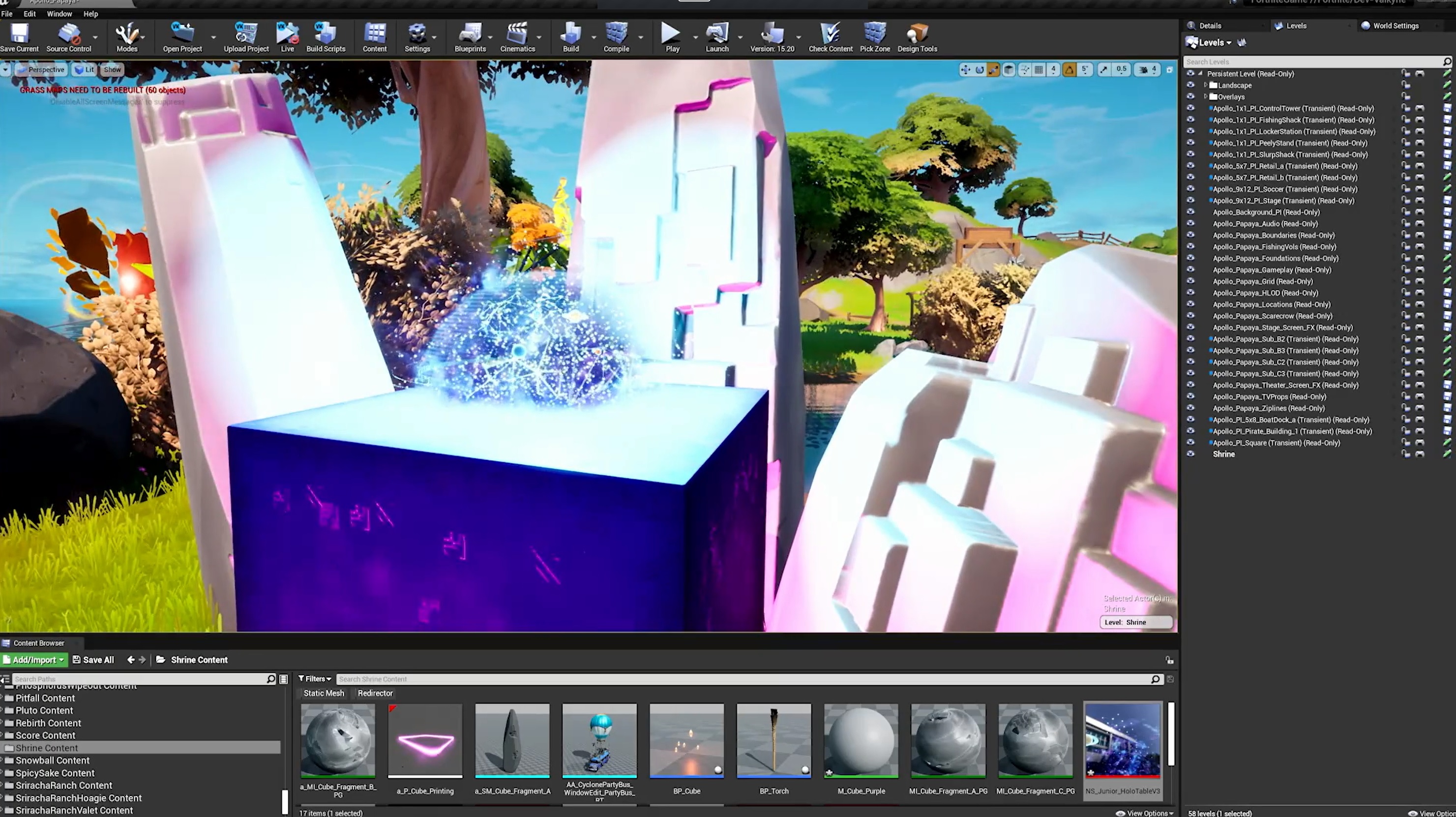The state of Fortnite in 2021
The battle royale phenomenon is as healthy as ever.

Fortnite is barely three years old. For all the transformation still undergoing Fortnite, 2017 feels like too small a distance for a game to have gone from rumored vaporware to global phenomenon. I scored the earliest version of Fortnite a 55 at the time, a clearly troubled project that Epic Games just needed to get out after spinning its wheels in development purgatory. Fortnite would either take on new life in the hands of players or fizzle out and die of natural causes. It happens.
But just as the battle royale craze spun up in the wake of PlayerUnknown's Battlegrounds' surprise success, Epic pulled an historic U-turn and put out Fortnite: Battle Royale, then a simple spin-off developed in three months. Over time Fortnite's improvisational development helped establish a modern vocabulary for live games with in-game events, battle passes, and consistent seasonal cycles. Fortnite saw the rise of Ninja and mainstream Twitch celebrity at large, it saw Epic try out bonkers marketing stunts like the complete shutdown of Fortnite for a few days just to generate awareness and usher in Chapter 2. Fortnite became such a cultural, money-printing force that Epic went as far as to abandon the iOS platform as a form of protest over "monopolistic practices," even accompanying the move with a parody of Apple's own 1984-inspired Macintosh ad.
Here's what to expect from other major ongoing games in 2021:
And now, in 2021, Fortnite is still trucking along, still making stuff up on the fly, but it's settled into a more comfortable rhythm. Fortnite is a battle royale toy box without a bottom, and with every recognizable character and brand waiting for their turn in the item shop. Even if you've played before, look away for a second and Fortnite will take on a totally new look when you turn back. So let's take a look at the state of Fortnite in 2021 and try to guess how this megagame might transform further.
What's been happening recently?
Someone's dad got a hold of the skin machine apparently
The theme of Fortnite's latest season, Chapter 2 Season 5, is dimensional overlap, which directly translates to The Season of Brand Partnerships. Fortnite's become a veritable action figure toy box, with a wider range of cameos across movies, videogames, and sports than ever before. In just a few months, we've seen an official Kratos skin (God of War), Din Djarin of The Mandalorian, and a Master Chief skin (Halo) replete with a Warthog riding emote. Someone's dad got a hold of the skin machine apparently, because one of the most popular games for kids even saw the god damned spine-ripping Predator show up.
Let's check the news feed live as I write this and—welp, Sarah Connor and the Terminator have joined the fight.

Some of the cameos are integrated directly into the main battle royale game mode too. Predator arrives with a small jungle biome. Land there to fight the damn thing, the Predator equipped with special melee attacks, cloaking abilities, and super speed. Take them down, though, and you can take the cloak for yourself, turning temporarily invisible at will. These mythic items, once an overpowered nightmare, have become one of the many recent additions central to every Fortnite match. Let's take a look at the rest, including one easily overlooked.
Mythical weapons and items are a major focus. The highest tier of tool in Fortnite is only available at specific locations, and only awarded for taking out a named character—or paying them a big gold bar bounty (more on that below). They're a high-risk, high-reward advantage for players, but come in handy for the less skill builders, and are a nice, rewarding diversion from the usual PvP bouts. A few favs: The Nighthawk, a scoped thermal pistol; the Mandalorian's jetpack, because duh. It's a jetpack.
Keep up to date with the most important stories and the best deals, as picked by the PC Gamer team.
Epic's experimenting with the in-game economy to keep players happy and the pace up. Gold bars, introduced last December, are earned by completing NPC quests or bounties, the former being anything from catching fish to harvesting materials, and the latter by eliminating a specific player. It might sound like a big ask, but gold can upgrade weapons, buy good ones outright, and get an NPC to play bodyguard for the rest of the match. Gold bars are really Epic's way of playing with pacing by asking players to make tough decisions more often, whether they're camping in a bush or cleaning up the lobby. For players without the reflex and ability of a pro-builder, a loaded kit and bodyguard go a long way.

Friendly, quest-giving NPCs have arrived. I sure glossed over that one above. I'm good buds with a sentient stack of pancakes named Mancake.
Vehicles are more common, but more grounded. Cars are all over Fortnite now, but you'll need to keep them filled up on gas, either from stopping at gas stations or sacrificing an inventory slot to carry a canister with you. They're more of a temporary traversal tool, for repositioning, escaping the storm, or kicking off a tower-destroying offensive maneuver—useful, but not overpowered. We're far from the baller and mech era of Fortnite.
The weapon pool is still constantly changing. Design changes masquerade as new weapons, and the shotgun continues to be the most obvious vehicle for Epic's endless balance problem, though I see it more as a gift. No one likes a solved meta, and new weapons like the lever shotgun change damage values, spread, distance, and fire rate just enough, just often enough, to keep players of all skill levels on their toes. Compared to other BR games like Warzone, where item pool changes are largely restricted to seasonal updates, Fortnite's meta is a constantly moving target.
Are players happy?
Are they ever? If you were to ask the original diehard Fortnite players, they'd probably say Epic is catering to inexperienced players too often. Historically, any item that counters skillful building is viewed as cheap, and the mythic items are constantly called out as such. But it's those mythic items, the bounce pads and grappling hooks, that keep more casual players like me playing Fortnite. Epic knows it can't make everyone happy, and rides the line pretty carefully overall.

Travis Scott's recent concert appearance in Fortnite attracted a massive 12.3 million players and earned the hip-hop artist $20 million from the event. Expect more big shows in Fortnite soon.
Skill-based matchmaking remains a point of contention, something I'm not sure any competitive game can avoid. Skilled players are funneled into skilled lobbies, where Fortnite's competitive meta caves a bit and becomes a much different turtling, tunnel-snaking game where player ping calls most buildfights into question. A valid complaint or problems inherent to any popular, complex competitive shooter? I think we're all still trying to figure it out.
Some of the early streamers and pro-players are slowly falling away. Fortnite is no longer the Twitch and YouTube game. It's facing more competition than ever, with big names like Ninja and Myth falling off for other competitive ventures in Valorant and Warzone, or entertainment streamers and YouTubers finding the fields a bit greener in surprise hits like Among Us and Fall Guys.
A slow descent from number one every day on Twitch to a regular spot in the top 10, often the top five games, suggests a natural, slow settling rather than an exodus. In truth, Fortnite has maintained an impressive monthly average concurrent viewership on Twitch over the years. According to TwitchTracker.com, Fortnite's monthly average concurrents peaked in July 2018, with 205,000 viewers. Things began slowing down in the back half of 2019 and early months of 2020, with sub-100K monthly averages, coinciding with the abnormally long extension of Chapter 2 Season 1. Since returning to the three-month season pace, Fortnite is back up to 100-150K monthly concurrent viewership averages.

That's pretty damn healthy after all this time, especially after ditching iOS. It's unclear if Fortnite can ever be the global phenomenon it once was, but I don't think it needs to be. Like Counter-strike or Call of Duty, Fortnite is the water now. Epic has the resources and reach to reinvent Fortnite whenever it likes anyway.
For now, Fortnite remains a great battle royale shooter, with a building system that allows for improvisational offensive and defensive maneuvers, and still a goofy sandbox overstuffed with odd toys. I get absolutely ruined in most Fortnite matches, but no two matches ever feel the same. Fortnite is an ever-evolving, amorphous blob of great game design. I get the impression that the base Fortnite audience is pretty happy with seeing whatever Epic cooks up next. As a more casual player, my interest is largely pinned to my curiosity and unless Epic gives up on Fortnite completely, plenty of us will stick around to see what forms the blob takes.
When's the next big update coming?
Fortnite seasons generally last around 10 weeks, but that's not a strict timetable. Right now, the in-game schedule says Season 5 continues through March 16, so we're expecting a big seasonal update to drop in the following days, possibly weeks. But what is it gonna be packing? Your guess is as good as mine. We'll get the usual map updates, new skins, new items, possibly some new systems, but as for what visual, thematic flavor they'll take, we're clueless.
If you told me that I'd be hunting the damn Predator in Fortnite a couple months ago, I would've laughed. Now? Hell, maybe we'll take down The Karate Kid next. See you in Chapter 2 Season 6: Austin Powers' Sexy Island Takeover.
Fortnite's future, according to Epic Games

Best Fortnite skins: Finest virtual threads
Fortnite Creative codes: Best custom maps
Fortnite map: Season 5 POIs
Fortnite Mandalorian challenges: Get the Beskar armor
Fortnite gold and bounties: What you should know
Fortnite exotic weapons: Where to find them
Given that unpredictability has become part of the game's formula, Epic hasn't publicly declared a clear direction for Fortnite's future. But given the cadence established by seasonal updates, expect business as usual until a more transformational chapter update. Chapter 1, the first 10 seasons running from 2017 through 2019, was Fortnite battle royale's true beta period, where Epic found a steady update rhythm, played around with live in-game events, and found a safe space to perpetually balance traversal, building, and precision gun-play against one another in a battle royale sandbox.
Chapter 2 finds Fortnite in its stride, the updates more nuanced and less jarring. Rather than chaos-inducing mechs, Chapter 2 gets updates like a gold bar economy to more subtly influence pace and expression. But some signs are stacking up: vehicles with improved physics, friendly and enemy NPCs, quests—Fortnite is coming to life in a big, systemic way. Epic is tweaking a battle royale game, sure, but simultaneously building all the pieces that make up open world games and RPGs right in front of us. The future of Fortnite, according to Epic's ongoing design decisions, is that Fortnite will be much more than a simple battle royale game in the future. It's been a concert venue, a movie theater, and a carnival, so why can't it be literally everything else?
Fortnite's future, according to us
Creative mode is Fortnite's true dark horse. In 2020, Epic is updating Fortnite Creative with some Unreal Engine 5 creation tools, including the ability to import custom assets. Fortnite's Creative mode is already home to thousands of impressive player-made experiments, but they are a little too boxed in by the limited toolset. If Fortnite Creative was LittleBigPlanet, where creations always feel a little Fortnite-y, expect the new version to hit more like Dreams, where players will have much more control over how their creations look and play, from coding to asset creation to custom particle effects.

We could very well see a new development community pick up momentum and create some of the most interesting mods this side of 2020, some that you wouldn't know were made in Fortnite unless someone told you. Like the Source mod boom of the '00s, Fortnite Creative could be where we see a new generation of PC devs take the training wheels off.
What food will Epic give a skeleton and sentience to next?
Please stop doing this, Epic. Think of the children.
James is stuck in an endless loop, playing the Dark Souls games on repeat until Elden Ring and Silksong set him free. He's a truffle pig for indie horror and weird FPS games too, seeking out games that actively hurt to play. Otherwise he's wandering Austin, identifying mushrooms and doodling grackles.


